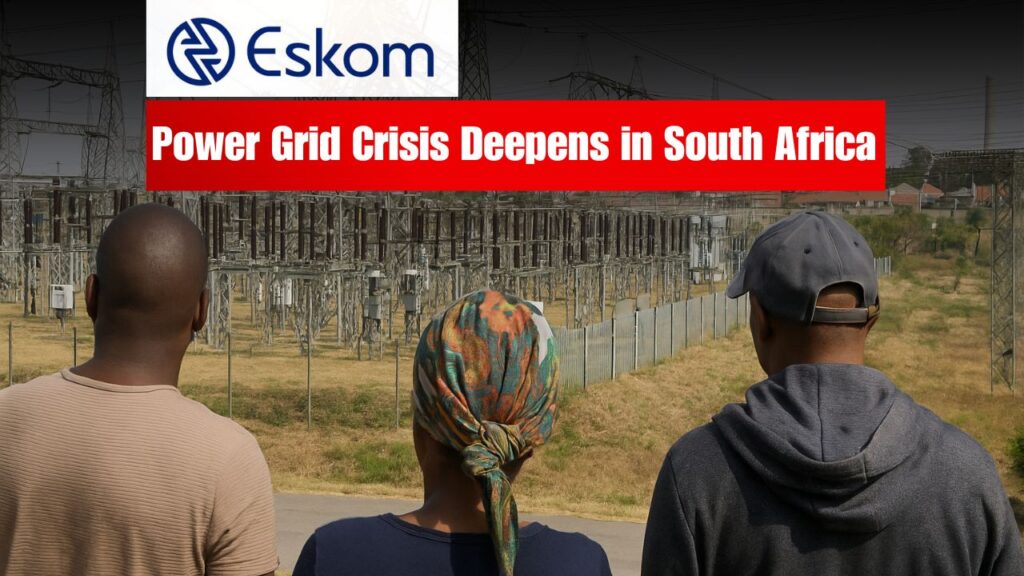South Africa’s national power utility, Eskom, has sounded the alarm once again as it warns that load shedding could persist until at least mid-2026. With the power grid still under immense pressure, maintenance backlogs, aging infrastructure, and delayed new generation projects have worsened the crisis. Eskom officials revealed that demand continues to outstrip supply despite ongoing repair and refurbishment efforts. The utility has intensified its focus on stabilizing coal-fired stations and integrating renewable energy, but experts believe the full balance between demand and production may not be achieved for another 18 to 24 months.

Why South Africa’s Power Grid Remains Under Severe Pressure
Eskom’s power grid challenges stem from decades of underinvestment, mismanagement, and technical inefficiencies. The utility faces daily breakdowns at several major power plants such as Medupi and Kusile, leading to reduced energy output and frequent Stage 2 to Stage 6 load shedding. Experts have also pointed to the slow rollout of renewable projects under the Independent Power Producer (IPP) program, which has failed to meet targets for sustainable capacity. Moreover, Eskom’s aging fleet of coal stations—many operating beyond their design life—struggles to maintain reliability, creating a fragile balance in South Africa’s energy ecosystem.
- Frequent breakdowns at major coal plants.
- Slow addition of renewable and independent power sources.
- Maintenance backlogs and funding limitations.
- Rising national electricity demand amid economic growth.
Eskom’s Plans to Tackle Load Shedding Until 2026
To mitigate the crisis, Eskom has introduced a two-year strategic plan focusing on grid recovery, renewable integration, and improved maintenance protocols. The plan includes refurbishing outdated plants, accelerating procurement of renewable power, and collaborating with private energy producers. By mid-2025, Eskom aims to restore up to 3,500MW of generation capacity through technical upgrades and improved coal supply reliability. The government has also fast-tracked approvals for solar and wind farms, aiming to reduce dependency on aging coal plants and ease the grid strain by mid-2026.
- Restoration of 3,500MW capacity by 2025.
- Expansion of solar and wind energy projects nationwide.
- Public-private energy partnerships under review.
- Increased investment in grid stabilization programs.
 New Electricity Billing Starts October 2025 Prepaid Meter Readiness Checklist & Avoid Power Cutoffs
New Electricity Billing Starts October 2025 Prepaid Meter Readiness Checklist & Avoid Power Cutoffs
Impact of Extended Load Shedding on South Africans
The continuation of load shedding until 2026 is expected to have far-reaching effects on households and businesses across South Africa. Small businesses face severe losses due to power disruptions, while households are struggling with appliance damage and increased fuel expenses from generator use. Economists warn that consistent power cuts could hinder economic growth by up to 2% annually. Industries such as mining, retail, and manufacturing are already shifting to solar solutions to sustain productivity. Meanwhile, citizens continue to face higher electricity tariffs, compounding the financial strain of frequent outages.
- Economic slowdown and rising unemployment risk.
- Increased living costs due to generator fuel and maintenance.
- Business reliance on alternative energy solutions.
- Higher tariffs impacting low-income households.

Current Load Shedding Stages and Future Outlook
Eskom’s operational forecasts suggest that the country may continue to face frequent Stage 2 to Stage 4 load shedding for the remainder of 2025, gradually decreasing in 2026 as new power sources become available. The Department of Energy is pushing for decentralized energy production, enabling municipalities and private firms to generate and sell power independently. If implemented effectively, these reforms could mark a turning point for South Africa’s energy landscape. However, until major repairs and investments are completed, citizens are urged to conserve energy and prepare for ongoing interruptions.
- Stage 2–4 load shedding expected through most of 2025.
- New IPP and renewable projects to come online in 2026.
- Municipal power generation reforms in progress.
- Government appeal for public energy conservation.
| Year | Expected Load Shedding Level | Eskom Focus Area | Planned Capacity Increase |
|---|---|---|---|
| 2024 | Stage 3-6 (Frequent) | Plant maintenance and repair | +1,200MW |
| 2025 | Stage 2-4 (Moderate) | Renewable integration and upgrades | +3,500MW |
| 2026 | Stage 1-2 (Stabilizing) | IPP and municipal generation | +5,000MW |
| 2027 | Minimal or None | Energy self-sufficiency goal | +7,000MW |
FAQs
1. Why is load shedding continuing in South Africa?
Due to aging infrastructure, high breakdown rates, and delayed renewable projects.
2. When is load shedding expected to end?
Eskom expects stability by mid-2026 if planned upgrades are completed on schedule.
3. What is Eskom doing to solve the problem?
The utility is restoring old plants, adding renewable energy, and improving maintenance efficiency.
4. How can citizens cope with load shedding?
By using solar panels, battery systems, and conserving electricity during peak hours.




